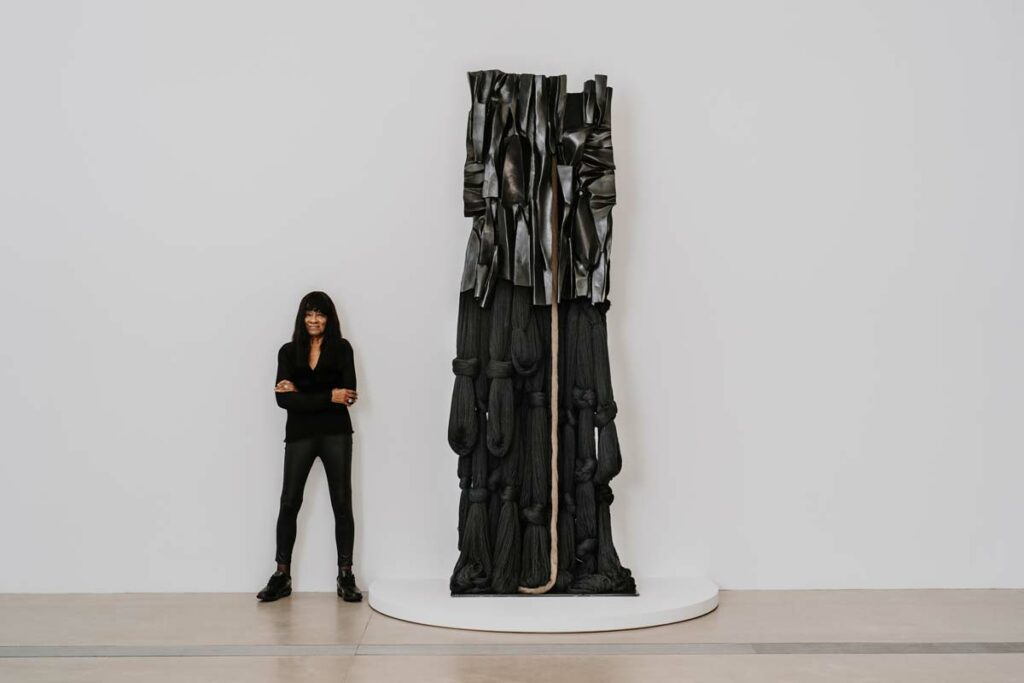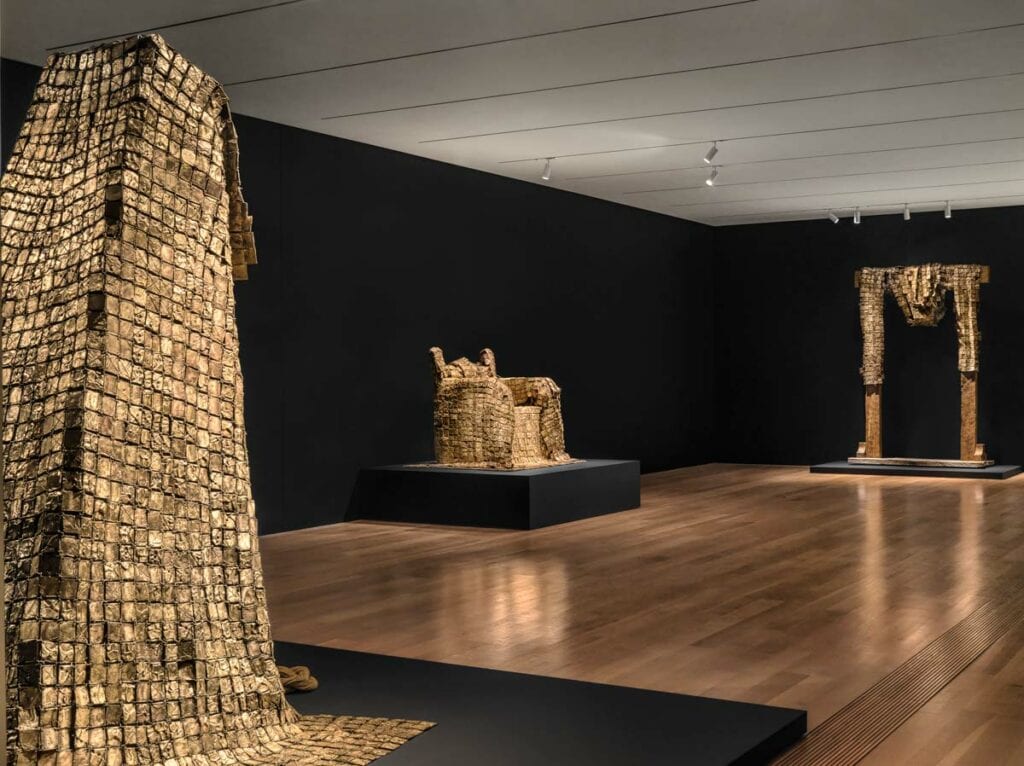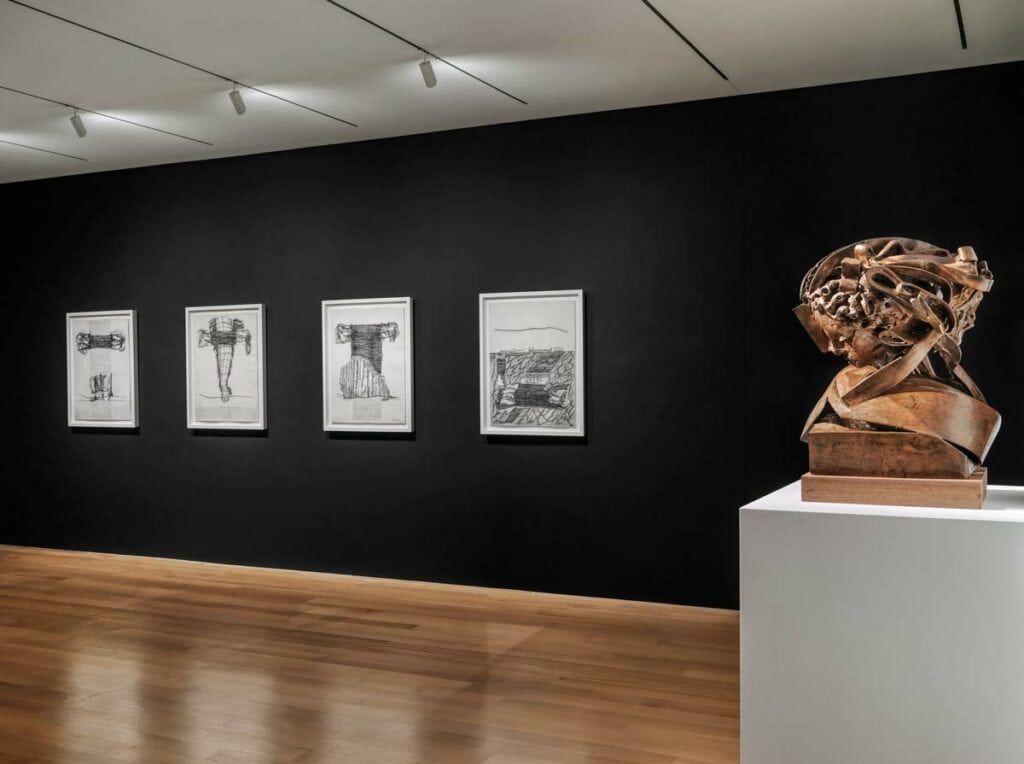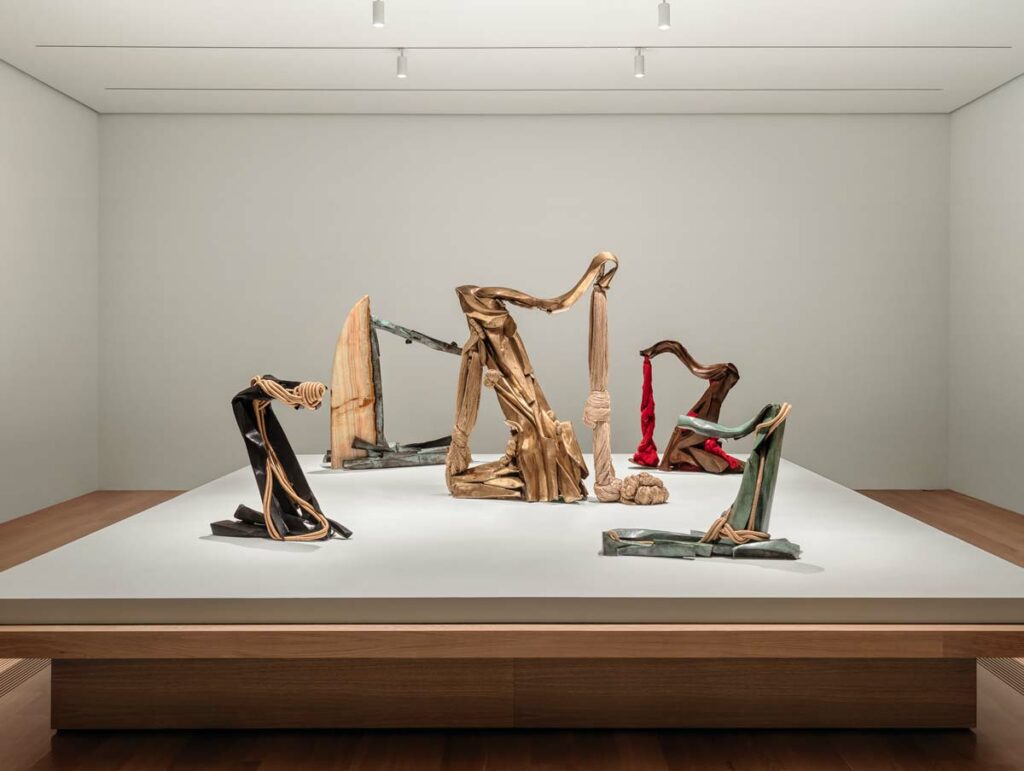What a delight it is to come across an exhibition by such a prominent artist as Barbara Chase-Riboud (b. 1939), whose elaborate charcoal drawings and exquisitely polished or patinated bronze sculptures sit atop intricate skirts woven with fiber sculptures have strangely eluded me all these years. A Philadelphia-native who has been Paris-based since 1960, Chase-Riboud is not only a visual artist, but she is a prize-winning poet, best-selling novelist, former modern dancer, and trained pianist. Moreover, trips to Rome (1957), Egypt (1958), China (1965), Algeria (1966 and 1969) inspired her early on. Why she is not an artworld household name is anyone’s guess, especially since she: sold Reba, a woodcut made when she was 15, to MoMA in 1955; presented her cast bronze Victory of a Bullfighter (1958) alongside sculptures by George Braque, Alexander Calder, and Anthony Caro at the 1958 Carnegie International, and exhibited in the Whitney’s 1970 contemporary sculpture survey, 1972 Whitney Biennial, and documenta 6 (1977). Concurrent with “Monumentale” is “Infinite Folds,” a simultaneous career survey on view at the Serpentine Gallery in London.

Chase-Riboud attributes her love of bronze to its being “timeless,” the preferred material of Benin and Baroque artisans alike. One explanation for her sculptures’ “low profile” is that shipping such towering structures cast in a Rome foundry across the Atlantic is expensive. Still, this factor hardly impeded the international careers of her “heavy-metal” peers Lynda Benglis, Eduardo Chillida, Mark di Suvero, Anish Kapoor, Martin Puryear, Richard Serra, or William Tucker. What’s clear, however, is that her oeuvre couldn’t be timelier, given our public discussions regarding which ‘heroes’ deserve remembrance. It’s a pity that “Monumentale” isn’t traveling, since it could surely coax needed forums/reforms on this front.

Although it’s difficult to situate her sculptures amidst a single movement that arose since the fifties, art historian Judith Stein likens Chase-Riboud’s process of casting pleated sheets of red wax to process art from the 1970s such as Lynda Benglis’s pours, smears, and knots; Eva Hesse’s gravity-bound suspended pendants and webs, Robert Morris’s felt stacks collapsing under their own weight, or Serra’s “folding, coiling and flinging” led. Even if yesteryear’s critics valued post-minimal sculptures for their process, as if they lacked content or purpose, they are no less allegorical than Chase-Riboud’s abstract tributes.

Among the 31 larger-than-life bronze or aluminum geometric sculptures and 18 sketches for unrealized monuments on view here, over half pay homage to known historical figures such as: black women (1966), Nostradamus (1966), Chines Consort Zhen (1967 and 1997), painter Gustav Courbet (1967), Black Nationalist Malcolm X (20 or so since 1969), Queen Cleopatra (1984-2000), Peter Paul Rubens’ mother Maria Pypelinckx (1996), Emile Zola (1996), the Hottentot Venus Sarah Baartman (1997 and 1998), singer Marian Anderson (2003), dancer Josephine Baker (2007), Shaka Zulu (2007), Chairman Mao (2007), and former Philadelphia Museum of Art Director Anne d’Harnoncourt (2008).

Although Chase-Riboud attributes her furnishing her sculptures skirts made from silk, wool, and synthetic fibers to the Senufo and Mandé peoples living in Central and West Africa, whose masks with raffia tendrils disguise their wearers, I rather associate her use of massive skeins of cording to fiber regalia signaling achievements such as graduation tassels, military raiment, and royal finery. In 1996, France awarded her the medal of the Légion d’honneur, an award she had craved ever since Josephine Baker was knighted in 1961, so Chase-Riboud is no stranger to achievement. In fact, she has three honorary doctorates and has won numerous literary prizes.

This same imagery also recalls dreadlocks, which prove just as timeless a hairstyle as folds and bronze are timeless sculptural forms and materials, since dreads were worn by ancient Greeks, early Christian ascetics, Islamic dervishes, Aztec priests, Massai warriors, Indigenous Australians, Tibetan Buddhists, Native American tribes, and more recently Rastafarians.
She credits renowned fiber artist and Yale classmate Sheila Hicks with having suggested that she integrate fiber into her sculptures. The flexible/inflexible invoked by dangling plaits and frozen pleats evokes the push/pull familiar to abstract painting. The mix of fiber and bronze is especially effective for her ongoing series La Musica, whose sinuous shapes sporting silky strands prompt sounds of strings being plucked in one’s mind’s ear, no doubt an effect inspired by her love of opera and piano music.
What truly sets Chase-Riboud’s artistic practice apart from her peers is the back and forth between the written word and the crafted object. “Monumentale” rather explicitly explores this relationship for six cases: her poem “Mao’s Organ,” inspired by her 1965 trip to China, gave rise to her 2007 sculpture; her 1966 poem “Le Lit” led to a series of increasingly abstract drawings of beds (1966-1973); her 1969 epic poem “Why Did we Leave Zanzibar?” grounded her magnificent Zanzibar series of the early 1970s; her poem “On Hearing Marian Anderson” roused her 2003 sculpture; her 1997 drawing and 1998 bronze bust that memorialize Sarah Baartman motivated her 2003 historical novel Hottentot Venus; and her poem “Cleopatra LIV” stimulated her stunningly golden Cleopatra series, whose multi-colored cast-bronze plaques are draped over oak. In line with Chase-Riboud’s talent at fiction, she invented whole cloth Cleopatra’s Marriage Contract (2000), formalizing Cleopatra’s marriage to Mark Antony with official seals, inscribed in the illegible automatic writing developed by her decades ago.
This exhibition will no doubt spark thoughts regarding which public figures ought to be memorialized. “Barbara Chase-Riboud Monumentale: The Bronzes” is on view thru February 5, 2023 at the Pulitzer Arts Foundation in Saint Louis, Missouri.